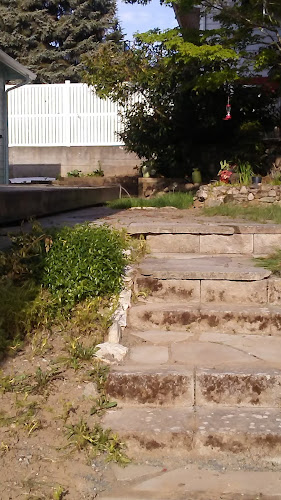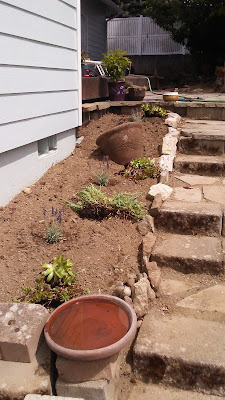"If we can teach people about wildlife, they will be touched. Share my wildlife with me. Because humans want to save things that they love."
Embracing
wildlife in the garden brings innumerable rewards. Creating wildlife-friendly
plantings is how we do it. Consider what
comes into your yard already. Do you want them to keep coming? Do you want something that you don’t see?
It’s
simple really. Animals and insects need food, water and shelter just like you
and me. Incorporate plants that will attract what you want to see more of into
your garden spaces.
When
buying plants for your garden, many plant labels give some wildlife information
that can help you make your choices. The most common symbols I see on labels
are for attracting butterflies, pollinators and hummingbirds and for deterring
rabbits and deer.
Firstly,
water. Be sure to add a fresh water source or two to your garden for them to
drink and/or bathe in. And remember to keep the water fresh and its container
clean. You may need to hose it out and refill it daily depending on its
popularity. Be sure to locate your water container where you can see it often,
every day. You will be rewarded by seeing the wildlife that comes to it.
Thrush at the fountain.
Robin at the water bowl.
It
doesn’t have to be elaborate. This (above) water bowl is just a saucer that is
sold for catching water under pots.
If you
have cats or dogs that visit your garden, I would suggest not putting a water
source this low to the ground. You can raise it up on a tall stump or a stack of
bricks or concrete blocks. Safety to the wildlife is key in enjoying them in
your garden.
The
depth of the water will attract different size birds for bathing. Shallow bowls
will attract smaller songbirds while deeper water will be easier for large birds
to bathe in. And hummingbirds love flitting through a mist, so a pump with
spray may be in order for you.
As for
shelter, birds not only use birdhouses for rearing their young in the spring
and summer, they can also use it for shelter during winter storms.

Be sure to
keep them mounted at an accessible height for you but out of reach for cats. I
do clean the bird houses out late each winter before birds actively begin
searching for a place to nest. A couple of times there were unhatched eggs that
had rotted or babies inside that had died. It needed to be cleaned out or new lodgers
would not have come, I think.
Lastly
is the topic of feed. Best, first and foremost, are plants that offer natural
food sources like nectar, pollen and berries all throughout the year, not just
summer. In the two photos below, honeybees are gathering pollen or nectar to
take back to their hive.
 Honey bee on Helianthus ‘Lemon Queen’
Honey bee on Helianthus ‘Lemon Queen’ Honeybee on Verbascum chaxii ‘Album’
Honeybee on Verbascum chaxii ‘Album’
When
you attract insects, don’t begrudge them taking advantage of your plants for their
needs other than food. In the next photo, this is not damage in my opinion. This
is evidence of the leaf cutter bee.

They cut
out perfect circles in soft leaves. They then fly back with the disc to use as packing
material for its tubular nest to protect the larvae till ready to hatch. I
welcome these holes and smile every year when I see leaf cutter bees are active
in my garden. If you happen to see one in the very act of leaf cutting, you are
very lucky indeed. It is fun to watch. Leaf cutter bees are passive and one of the
many native pollinators here in the U.S. We need them.
Food
supplementation is not without controversy, but I do believe it has a legitimate
place in the wildlife friendly garden. If your garden does not offer winter
food sources naturally, you may consider feeding.
Suet
for bird feeding is a debated form of feed, but I do offer it during all the
cold, rainy months.
Winter
winds drive winter’s rain into seed feeders of all types in my experience. Soggy
seed feeders are a mess to keep clean and molded seed is hazardous to your
feathered visitors. I choose to feed suet because it is not affected by rain,
it is consumed quickly and many species of birds come to it.
The hummingbirds
will find nectar in a very large variety of flowers.
Commonly
they are seen sipping from the plants with more tubular shaped flowers like
penstemon, salvia and fuchsia. However, I
have also seen them on roses, and in the winter months they visit my Camelia ‘Yuletide’
which is not tubular, yet attractive to them by its red flowers and nectar
stores.
Here a
green Anna’s hummingbird enjoying nectar from flowers on the right hand side of
this pot of fuchsia plants.

If you
feed them with a syrup mixture, it is not recommended to use that red dye stuff
you buy at the store in a box. It contains a red chemical dye which is toxic
for people and birds alike. The red plastic tops and tubes on feeders are
enough to catch the hummingbird’s attention.
A
simple syrup you make yourself with equal parts table sugar and boiling water,
dissolved and cooled is better for them. Frankly they will find your offering
with no color on the feeder at all but if you want red, buy one that has red
parts. Or you could hang it with a red ribbon, tie on a red flower or use a red
‘write-on-glass’ pen to add some color to the glass bottle.
In
reality, hummingbirds also feed on lots of flowers that are not red. While the
color is attractive to them, it is not critical. Once they find your syrup
feeder, they will be back as long as you keep it clean and filled. Give it a
good wash out with a bottle brush before each refill. Check it weekly if not
more often. Sugar water can mold quickly especially if in a sunny location.
Shade is a more desirable choice. Depending on traffic, be prepared to fill it
weekly or every couple of days.
You may
find suggestions online for various syrup recipe ratios based on seasonal
changes. Honestly, I used to do that but don’t anymore. They come year-round to
my feeder with the same 1:1 water/sugar ratio recipe.
Feeding
deer or rabbit is another matter. Plant tags with a slash through an image of
deer or rabbit signifies plants that neither will tend to eat. If you have a
lot of foraging deer in your vicinity, don’t plant roses or other plants they are
known to devour. Personally, I would rather have the occasional deer wander through
my yard instead of a lot of roses.
Don’t
get me wrong. I like roses and have had many over the years. In my previous
garden I had 3 Old English roses in the back yard where the deer didn’t go.
There
are two roses in this garden that have been here for a very long time judging
by the size of the older canes. This guy nibbles a few blossoms each time he
comes by but he doesn’t devour the whole plant.
I will
keep the roses for the time being. I don’t really like where they are planted
nor do I know what kind they are, but they bloom all summer and well into the
winter, don’t require extra summer watering or fertilizer and must not be like
candy to the deer, like most fussy hybrid teas roses are.
Apparently,
deer like fuchsias too. I see hoof prints often in my garden after one or more
has been by the night before. Other than hoof prints the only evidence of
browsing I have seen was that he ate all the top blossoms off this big pot of
fuchsias pictured above. I don’t mind. I love seeing deer and we are not
overrun with herds of them where I live and garden. They left enough flowers
for me and hummingbird to enjoy too.
Deer are foraging wildlife. When food is abundant they will
be choosy. When food is scarce they will be less so. Understanding this, there
are many lists of deer resistant plants any internet search will provide you
with, as well as symbols on plant lables, but accept the fact that when food is
scarce they will eat even that which they may not prefer. They don’t read those
lists. The lists are simply guides for you and me based on someone elses
previous experience.
As for
bunnies, we had tons of them in the spring. They nibbled a few low-to-the-ground
flowers on the veronica but I didn’t mind at all. Mostly they just ate the soft fresh leaves of
the clover, dandelion and grass. I always leave clover in the grass anyway. It
feeds nectar to bees and pollinators and clover root fixes nitrogen in the soil
which feeds the grass. I have enjoyed seeing bunnies come by as part of my
local wildlife mix too and don’t mind their nibbling on some of the plants. There’s
enough to go around for us all to enjoy.
There
is so much more I could write on this subject, but hopefully this is enough to
whet your appetite for ideas if you want to create a wildlife friendly garden.
Here
in the USA, many states have a backyard sanctuary program. The signage in the
first photo proves my certification based on the requirements of the Washington
Department of Fish and Wildlife. If where you live has such a program, I encourage
you look into the certification requirements. The signage sparks interest and
conversation and maybe more wildlife friendly gardens will grow.
Thanks
for reading and happy gardening!
In
bloom in my garden today: Geum, Camellia ‘Yuletide’, Primrose, Calendula, Erica
carnea winter heath, Lithodora, Erysimum (wallflower)
Bird
photos courtesy of Patrick L. Chissus photography. You can see more of his work
on Instagram @nwmaritimephotography
All
other photos are mine.



















































